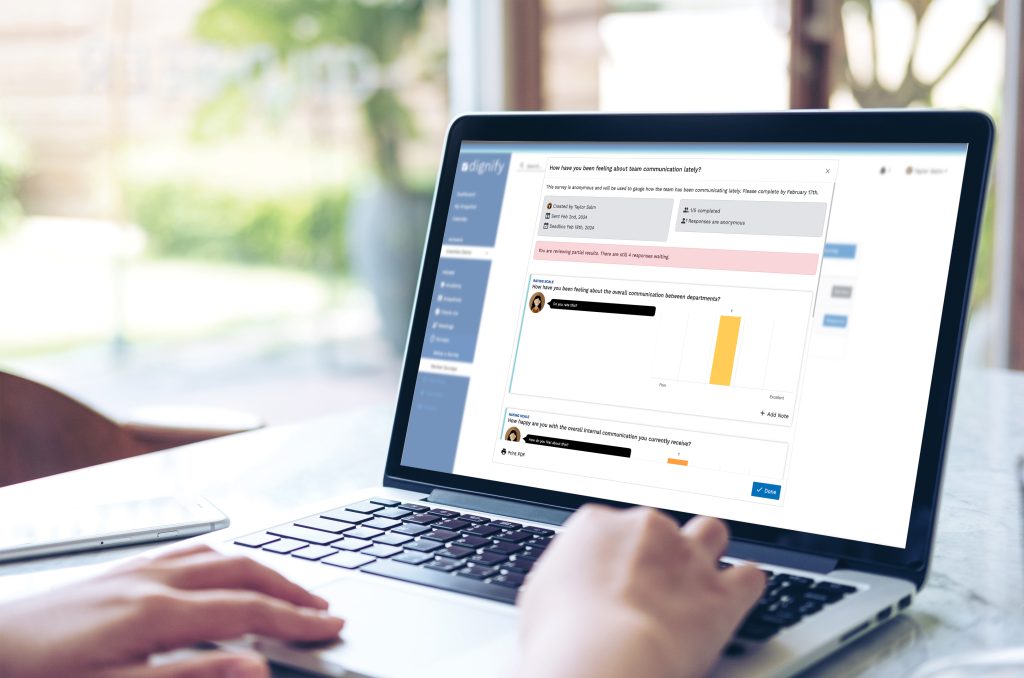Four best practices for creating employee surveys
Wednesday, April 24, 2024 - Dignify

Just like anything at work, there is a certain skill to creating an effective survey for your team and getting the answers you need. Although it seems simple, it’s not as easy as just creating a few questions and sending them out to your team via email. To put it in perspective, survey design and creation is a full-blown career path. For many, it is their full-time job.
So, there is an art to survey creation. While you don’t need to spend hours or days meticulously detailing a flawless survey for your team. All you need to do is set a side a little bit of time in your day to create it carefully so that you get exactly what the type of information you need, when you need it, and how you need it. Your goal is to get value from the responses, learn, and take action based off of them. In order to do that, you need to pay attention some employee survey best practices. Here are five that you should pay attention to:
- Establish a clear topic and focus for the survey
This may come across as obvious to a more experienced leader, but your survey should have one clear, focused topic and one clear purpose as to why it’s being sent in the first place. All of the questions you are asking should follow one theme and should be 100% relevant to that theme, without branching out to other topics. The theme should be made obvious to the employees answering the questions. Common survey themes include employee engagement, core values, communication, work-life balance, and many more.
- Use the right channel, provide time
When you’re planning to distribute a survey, you will want to do it using a platform that is most accessible and most commonly used by the people on your team. You can use email, company mobile apps, or wherever your employees are most likely to see the notification. If your company has invested in an employee engagement tool that has a survey feature, like Dignify, you can use that to distribute your survey and get a high response rate.
Employees who receive a survey also need time in their day to complete it. As their leader, make sure that they block off however much time on their schedule is needed to complete the survey, depending on how long it is. If the survey will be time consuming for people to fill out completely, make sure that you are understanding and compromising if they need to push back a deadline or two. It will be important that they have the time to answer the survey questions thoroughly and honestly so that you will have useful, actionable information.
- Develop your questions – avoid bad ones
As we mentioned in the first best practice, your questions should, above all, follow one single focused theme. Make sure that you don’t branch off to other topics or put in questions that are irrelevant to the theme of the survey. You want focused, actionable information from the answers you receive. Feel free to use different types of questions, including open-ended questions, rating scales, and multiple choice questions to tune their answers depending on what you are looking for. Depending on the question you are asking, one method might work better than another. For some questions, the answers are a simple yes or no, or a rating on a scale. For others, especially deeper or more subjective questions, it’s best to provide people with a space to provide their thoughts in an open-ended format.
There are some types of questions you will want to avoid, including double barreled questions (which is a question that asks about two topics yet allows for only one answer), leading questions (which prompts or encourages an answer that you, the questioner, desires), and more. For more information on what types of questions to avoid, view this comprehensive resource from Delighted.
- Set a deadline, follow up
Make sure that you set a deadline for your team to complete the survey so that you get the most accurate representation about how your team, as a whole, feels about the topic. In order to make sure each of your team members completes it, send multiple follow-up reminders to them before reaching the deadline to increase the likelihood that they will see it, block off time, and respond to it.
- Practice anonymity, if necessary
Anonymous feedback can have many different benefits, especially when you may be dealing with a sensitive or controversial topic. When employees are able to share their thoughts anonymously, they know that they can speak with 100% candor and honesty without the pressure of possible retaliation or direct conflict. Therefore, you’re likely to receive the clearest and most unfiltered picture about what is happening. Anonymity can help those who wouldn’t normally speak up to say what’s on their mind. Overall, you’re likely to get a lot more honesty, clarity, and nuanced insights through an anonymous survey than a transparent one.
In summary, crafting effective surveys for your team requires a level of skill and attention to detail. Key practices such as establishing a clear theme, choosing suitable channels, crafting focused questions, setting deadlines with follow-ups, and embracing anonymity for candid feedback are essential to creating an effective survey. By adhering to these employee survey best practices, leaders can harness the power of surveys to glean valuable insights, foster clear communication, and drive meaningful change within your organization.

